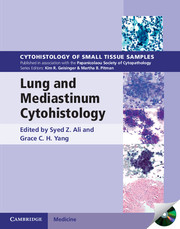Book contents
- Frontmatter
- Contents
- Contributors
- 1 Introduction to lung cytopathology and small tissue biopsy
- 2 Normal anatomy, histology, and cytology
- 3 Infectious diseases
- 4 Other non-neoplastic lesions
- 5 Benign lung tumors and tumor-like lesions
- 6 Squamous, large cell, and sarcomatoid carcinomas
- 7 Adenocarcinoma
- 8 Neuroendocrine neoplasms
- 9 Uncommon primary neoplasms
- 10 Metastatic and secondary neoplasms
- 11 Anterior mediastinum
- 12 Middle and posterior mediastinum
- 13 Role of ancillary studies
- Index
- References
3 - Infectious diseases
Published online by Cambridge University Press: 05 January 2013
- Frontmatter
- Contents
- Contributors
- 1 Introduction to lung cytopathology and small tissue biopsy
- 2 Normal anatomy, histology, and cytology
- 3 Infectious diseases
- 4 Other non-neoplastic lesions
- 5 Benign lung tumors and tumor-like lesions
- 6 Squamous, large cell, and sarcomatoid carcinomas
- 7 Adenocarcinoma
- 8 Neuroendocrine neoplasms
- 9 Uncommon primary neoplasms
- 10 Metastatic and secondary neoplasms
- 11 Anterior mediastinum
- 12 Middle and posterior mediastinum
- 13 Role of ancillary studies
- Index
- References
Summary
Introduction and background
Lower respiratory tract infections (LRTIs) are the leading cause of infectious deaths worldwide. In certain patient populations, for example, those with acquired immune deficiency syndrome (AIDS), it continues to be the most common cause of death. The vast majority of LRTIs that cause significant morbidity and mortality are bacterial and viral pneumonias in immunocompetent patients. These infections are more often diagnosed by clinical and laboratory findings alone. Fungal infections are the third most common type of LRTI and occur most frequently in immunocompromised patients (ICPs). Parasitic LRTIs are not infrequently encountered in people inhabiting tropical areas of Asia and Africa but they are exceedingly rare in most developed countries.
Mediastinal infections (MIs) occur much less frequently than LRTIs but are considered a surgical emergency and are associated with a very high mortality rate. In ICPs, acute bacterial infections are the most common followed by fungal infections. Parasitic infections very rarely involve this anatomical site.
- Type
- Chapter
- Information
- Lung and Mediastinum Cytohistology , pp. 32 - 62Publisher: Cambridge University PressPrint publication year: 2000

